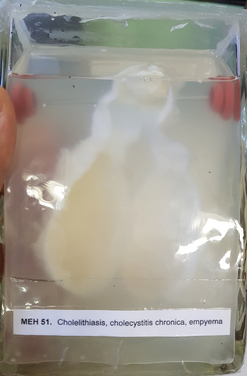13. Cholelithiasis, chronic cholecystitis and empyema: Difference between revisions
No edit summary |
No edit summary |
||
| Line 15: | Line 15: | ||
The consequences of gallstone depend on where it is stuck. If it is stuck inside the gallbladder or in the cystic duct, the consequence can be acute or chronic cholecystitis or even adenocarcinoma. If it is stuck in the common bile duct there will be post-hepatic or obstructive jaundice, cholangitis (inflammation of the bile duct). The cholangitis will be the ''ascending type'', meaning that the inflammation can spread upwards into the liver and even cause an abscess inside. If the stone is stuck in Vater’s papilla, there will be an acute or chronic pancreatitis. The latter will lead to fibrosis of the pancreas, which further leads to malnutrition and diabetes. The stone in this case is probably a cholesterol stone. | The consequences of gallstone depend on where it is stuck. If it is stuck inside the gallbladder or in the cystic duct, the consequence can be acute or chronic cholecystitis or even adenocarcinoma. If it is stuck in the common bile duct there will be post-hepatic or obstructive jaundice, cholangitis (inflammation of the bile duct). The cholangitis will be the ''ascending type'', meaning that the inflammation can spread upwards into the liver and even cause an abscess inside. If the stone is stuck in Vater’s papilla, there will be an acute or chronic pancreatitis. The latter will lead to fibrosis of the pancreas, which further leads to malnutrition and diabetes. The stone in this case is probably a cholesterol stone. | ||
Empyema is a type of inflammation where there is pus inside the gallbladder. The stones and stagnant bile are not good for the gallbladder mucosa and will lead to severe inflammation. The bladder will be filled with pus, blood and fibrin. | Empyema is a type of inflammation where there is pus inside the gallbladder. The stones and stagnant bile are not good for the gallbladder mucosa and will lead to severe inflammation. The bladder will be filled with pus, blood and fibrin. The whitish morphology with thick wall is due to fibrosis of the gallbladder following the chronic inflammation. Because of the whiteness, and how it looks on an x-ray the morphology is often called porcelain gallbladder.[[File:Porcelain gallbladder.png|center|thumb|Porcelain gallbladder|376x376px]] | ||
The whitish morphology with thick wall is due to fibrosis of the gallbladder following the chronic inflammation. Because of the whiteness, and how it looks on an x-ray the morphology is often called porcelain gallbladder. | |||
[[File:Porcelain gallbladder.png|center|thumb|Porcelain gallbladder| | |||
[[Category:Pathology 1 - Macropreparations]] | [[Category:Pathology 1 - Macropreparations]] | ||
Latest revision as of 16:54, 27 June 2024
Organ: Gallbladder
Description:
In the cystic duct (on the top) there is a large gallstone. The gallbladder itself is white, has a thick wall and is fragile (not noticeable when in glass of course).
Diagnosis: Cholelithiasis, chronic cholecystitis, empyema
Risk factors:
See theoretical topic 15.
Theory:
The consequences of gallstone depend on where it is stuck. If it is stuck inside the gallbladder or in the cystic duct, the consequence can be acute or chronic cholecystitis or even adenocarcinoma. If it is stuck in the common bile duct there will be post-hepatic or obstructive jaundice, cholangitis (inflammation of the bile duct). The cholangitis will be the ascending type, meaning that the inflammation can spread upwards into the liver and even cause an abscess inside. If the stone is stuck in Vater’s papilla, there will be an acute or chronic pancreatitis. The latter will lead to fibrosis of the pancreas, which further leads to malnutrition and diabetes. The stone in this case is probably a cholesterol stone.
Empyema is a type of inflammation where there is pus inside the gallbladder. The stones and stagnant bile are not good for the gallbladder mucosa and will lead to severe inflammation. The bladder will be filled with pus, blood and fibrin. The whitish morphology with thick wall is due to fibrosis of the gallbladder following the chronic inflammation. Because of the whiteness, and how it looks on an x-ray the morphology is often called porcelain gallbladder.

